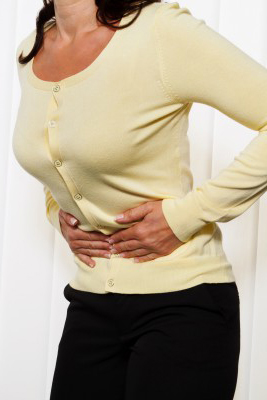Pelvic pain occurs in the lower abdomen and pelvis area. Individuals may experience pain continuously or it may also come and go. The pain may be dull or sharp and of varying severity. Sometimes the pain may be worse during urination, menstruation, or sexual activity. There may be many causes of pelvic pain which are associated with the reproductive system of women; for example uterine fibroids, ovarian cysts, ovarian cancer, menstrual cramps, endometriosis, infection of the pelvic area, and ectopic pregnancy. There are also many causes which are not related to the reproductive system like appendicitis, constipation, IBD, diverticulitis, fibromyalgia, inguinal hernia, IBS, kidney stones, urinary tract infection, and inflammation of the prostate for men. Chronic pelvic pain (CPP) is pelvic pain which lasts more than 6 months and is usually stronger than would be expected from the injury or condition which initially caused the pain. Individuals with CPP may have changes to their sleep, bowel movement frequency, appetite, mood, and energy.
- About
- Gastroenterology Services
- For Physicians
- DGBI Providers
- Patient Resources
- Communications
- Rome Drossman Communication Collaboration
- Gut Feelings Book
- Gut Feelings: The Patient Story Book
- Gut Feelings: Doctors & Patient-Centered Care
- Communication 101
- Communication 101.5
- Communication 202
- Presentations Videos
- Education Resources on Communication Skills
- Rome-AGA Communication Skills Workshop
- Visiting Scholars
- Contact
Pelvic Pain
This Is A Custom Widget
This Sliding Bar can be switched on or off in theme options, and can take any widget you throw at it or even fill it with your custom HTML Code. Its perfect for grabbing the attention of your viewers. Choose between 1, 2, 3 or 4 columns, set the background color, widget divider color, activate transparency, a top border or fully disable it on desktop and mobile.
This Is A Custom Widget
This Sliding Bar can be switched on or off in theme options, and can take any widget you throw at it or even fill it with your custom HTML Code. Its perfect for grabbing the attention of your viewers. Choose between 1, 2, 3 or 4 columns, set the background color, widget divider color, activate transparency, a top border or fully disable it on desktop and mobile.
 5826 Fayetteville Rd., Suite 201 Durham, NC 27713
5826 Fayetteville Rd., Suite 201 Durham, NC 27713  (919) 246-5611
(919) 246-5611 
